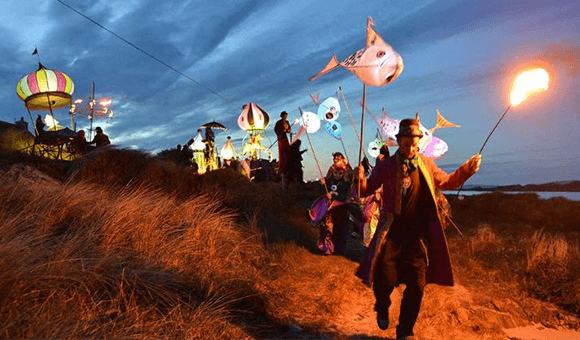
Popular events and gigs in the West of Ireland
There are dozens of Irish Festivals in the West of Ireland for locals and visitors.
Read moreIreland has several romantic traditions from history that are still very much part of the culture of Irish people living anywhere in the world.
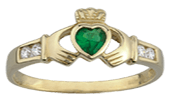 The Claddagh ring is said to have originated in the Claddagh fishing village in County Galway to symbolize love, loyalty, and friendship. The story goes that when captured by pirates, Richard Joyce collected flecks of gold to make a ring for his loved one of two hands holding a crowned heart, after years slavery, his true love had waited for him.
The Claddagh ring is said to have originated in the Claddagh fishing village in County Galway to symbolize love, loyalty, and friendship. The story goes that when captured by pirates, Richard Joyce collected flecks of gold to make a ring for his loved one of two hands holding a crowned heart, after years slavery, his true love had waited for him.
Worn on the right hand with the point of the heart toward the fingertips means the wearer is single and may be looking for love, though if it points to the wrist, the wearer is in a relationship. When worn on the left hand with the point of the heart toward the fingertips, the wearer is engaged and with the point of the heart toward the wrist means the wearer is married.
Irish history, myth, and legend include those of great romance. The story of Diarmuid and Gráinne contains all the ingredients of an epic romance: beauty, lust, betrayal, tragedy… Titanic, eat your heart out!
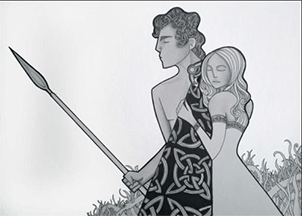 This story, harking back to the tenth century has some variations in the stories recorded, but is about Gráinne, engaged to the elderly widower Fionn MacCumhaill, Gráinne instead falls in love with one of Fionn’s warriors named Diarmuid and the couple elope, going on to have five sons. Fionn pursues them until Diarmuid meets a tragic end in which Fionn could have saved him but chooses not to. Today, the landscapes they traveled still bear testament to this love story: in County Sligo, above the Gleniff Horseshoe looped walk, “Diarmuid and Gráinne’s cave” was said to be the couple’s last hiding place; while across the Burren in County Clare, the megalithic tombs dotting the landscape are called “leaba Dhiarmada agus Gráinne” or bed of the lovers.
This story, harking back to the tenth century has some variations in the stories recorded, but is about Gráinne, engaged to the elderly widower Fionn MacCumhaill, Gráinne instead falls in love with one of Fionn’s warriors named Diarmuid and the couple elope, going on to have five sons. Fionn pursues them until Diarmuid meets a tragic end in which Fionn could have saved him but chooses not to. Today, the landscapes they traveled still bear testament to this love story: in County Sligo, above the Gleniff Horseshoe looped walk, “Diarmuid and Gráinne’s cave” was said to be the couple’s last hiding place; while across the Burren in County Clare, the megalithic tombs dotting the landscape are called “leaba Dhiarmada agus Gráinne” or bed of the lovers.
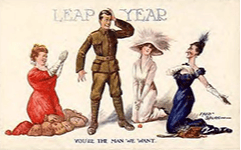 Legend has it that it was St. Patrick, the patron saint of Ireland and St. Brigid the lesser known second patron saint of Ireland, who made a deal that women could propose to their reluctant beaux on 29 February. The story goes that St. Brigid complained to St. Patrick about how long it took men to propose marriage. St. Patrick allowed for women to propose on 29 February, once every 4 years in a leap year.
Legend has it that it was St. Patrick, the patron saint of Ireland and St. Brigid the lesser known second patron saint of Ireland, who made a deal that women could propose to their reluctant beaux on 29 February. The story goes that St. Brigid complained to St. Patrick about how long it took men to propose marriage. St. Patrick allowed for women to propose on 29 February, once every 4 years in a leap year.
 The tradition of matchmaking remains as relevant to Irish culture today as in the past. Meeting people when you live in rural Ireland is not easy, particularly for those working in isolated professions like farming. Help has been available over the last 160 years in the form of the Lisdoonvarna Matchmaking Festival, the largest single’s event in Europe, which offers music, dancing and the chance to meet others. Lisdoonvarna is a hot water spring where hundreds flocked to partake the warm waters and was said to be the perfect place for farmers to find their brides in September and October once harvests were safely in.
The tradition of matchmaking remains as relevant to Irish culture today as in the past. Meeting people when you live in rural Ireland is not easy, particularly for those working in isolated professions like farming. Help has been available over the last 160 years in the form of the Lisdoonvarna Matchmaking Festival, the largest single’s event in Europe, which offers music, dancing and the chance to meet others. Lisdoonvarna is a hot water spring where hundreds flocked to partake the warm waters and was said to be the perfect place for farmers to find their brides in September and October once harvests were safely in.
 Before wedding ceremonies involved the exchange of rings, a handfasting ceremony that goes back to ancient historical traditions in Ireland, was the most common form of betrothal and marriage under Brehon Laws which would take place at large festivals at sacred sites. The ties represent the bind of the vows made, and the knot represents strengthen under pressure.
Before wedding ceremonies involved the exchange of rings, a handfasting ceremony that goes back to ancient historical traditions in Ireland, was the most common form of betrothal and marriage under Brehon Laws which would take place at large festivals at sacred sites. The ties represent the bind of the vows made, and the knot represents strengthen under pressure.
Today, the handfasting ceremony, which usually happens directly after the rings have been exchanged, can be just one cord with the hands wrapped by the celebrant or it can be a variety of colors that chosen guests can lay over the hands, with each color representing a gift or blessing bestowed upon the marriage.
Those in Ireland are famous for having the “gift of the gab,” from the poetry of WB Yeats to the wit of Oscar Wilde, the Irish offer lyrical inspiration when it comes to words of love.
When you are old and gray and full of sleep
And nodding by the fire, take down this book,
And slowly read, and dream of the soft look
Your eyes had once, and of their shadows deep;
On Raglan Road on an autumn day, I met her first and knew
That her dark hair would weave a snare that I might one day rue;
I saw the danger, yet I walked along the enchanted way,
And I said, let grief be a fallen leaf at the dawning of the day.
Ah! what else had I to do but love you? God's own mother was less dear to me,
And less dear the Cytheraean rising like an argent lily from the sea.
I have made my choice, have lived my poems, and, though youth is gone in wasted days,
I have found the lover's crown of myrtle better than the poet's crown of bays.
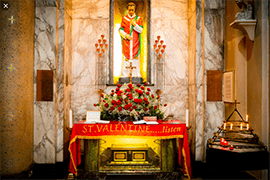 St. Valentine, the patron saint of love, was executed in Rome and buried there in the third century. In 1835, an Irish Carmelite priest, Fr. John Spratt was granted permission by Pope Gregory XVI to exhume his remains, and now his skeleton lies under Whitefriar Church in Dublin. Whilst it sounds a most peculiar practice, at the beginning of the nineteenth century, it was not uncommon for local churches to be given relics from the catacombs in Rome. Visitors to a shrine that was built in 1950 hope that prayer to Saint Valentine will give them the help they need to find a partner.
St. Valentine, the patron saint of love, was executed in Rome and buried there in the third century. In 1835, an Irish Carmelite priest, Fr. John Spratt was granted permission by Pope Gregory XVI to exhume his remains, and now his skeleton lies under Whitefriar Church in Dublin. Whilst it sounds a most peculiar practice, at the beginning of the nineteenth century, it was not uncommon for local churches to be given relics from the catacombs in Rome. Visitors to a shrine that was built in 1950 hope that prayer to Saint Valentine will give them the help they need to find a partner.

There are dozens of Irish Festivals in the West of Ireland for locals and visitors.
Read more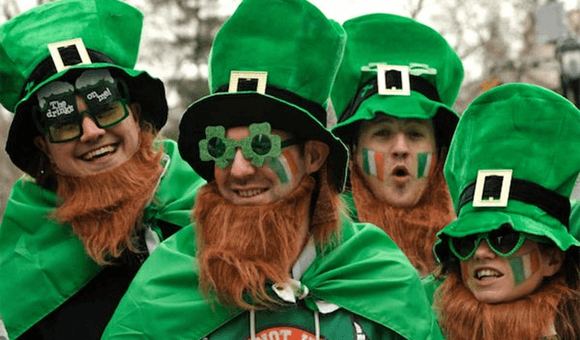
Ireland understands the power of ideologies to divide communities due to its a troubled relationship with its nearest neighbor in the North...
Read more